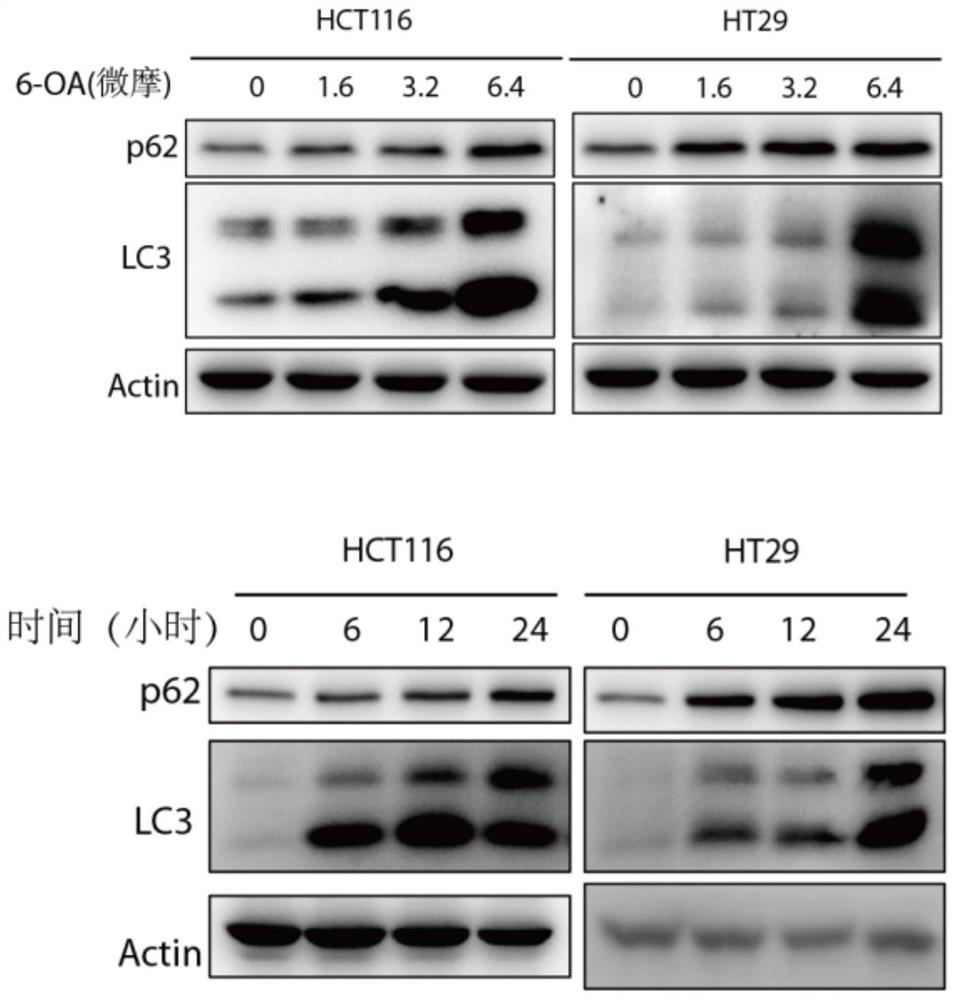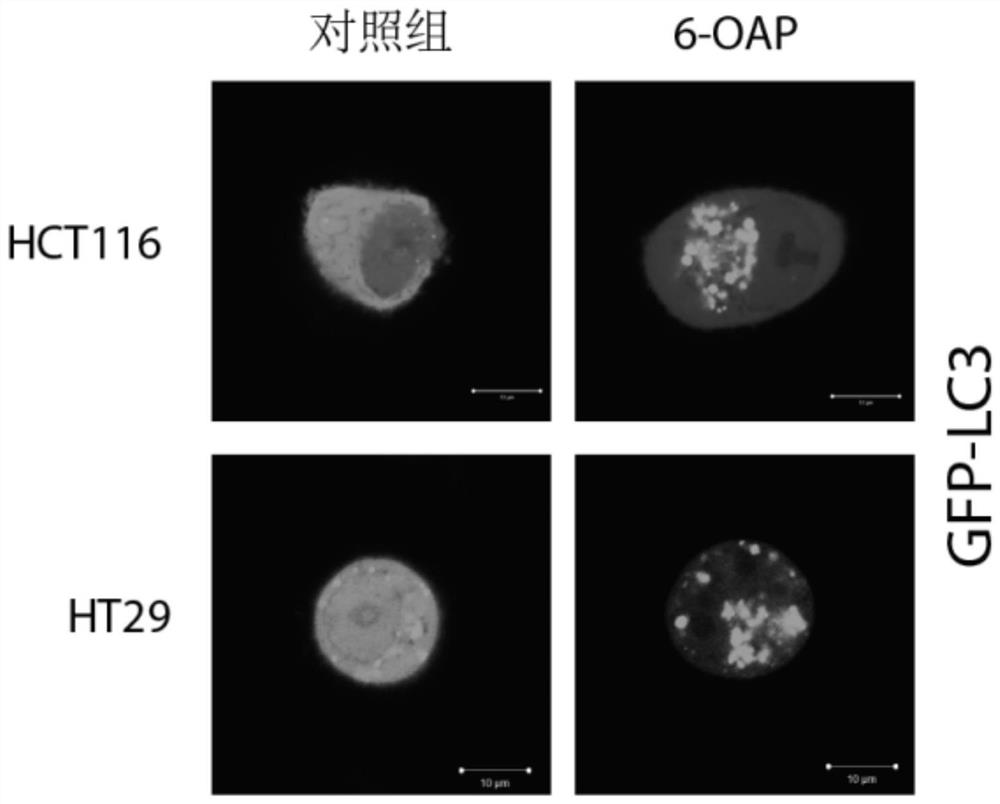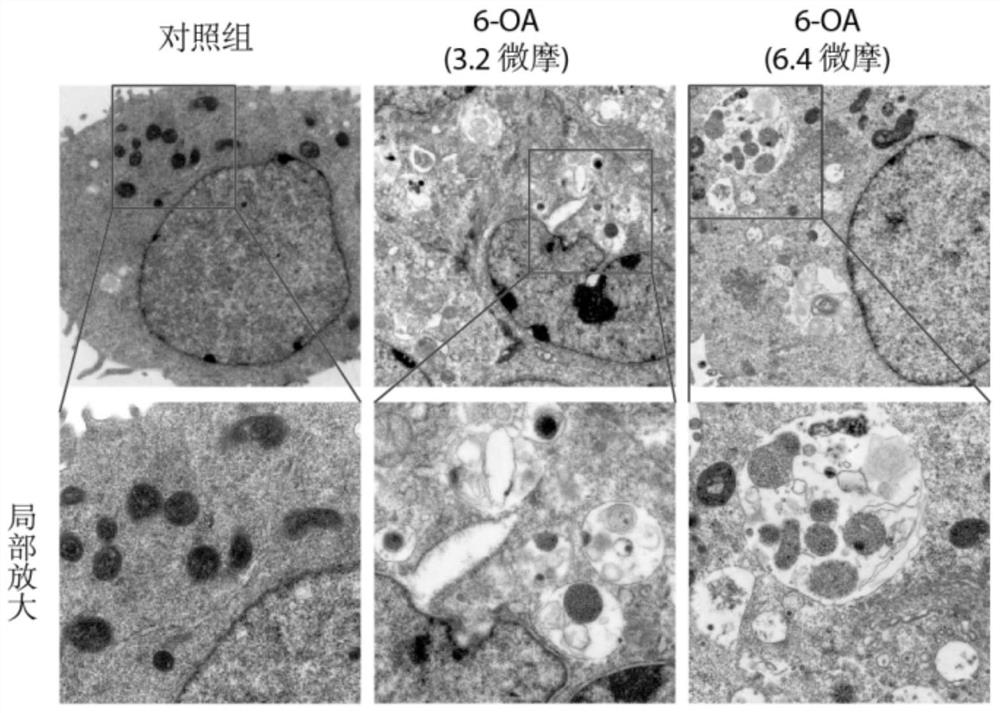Application of erodium stephanianum willd element as autophagy-lysosome signal channel blocker
A technology of signaling pathways, Cranedin, which is applied in the field of medicine, can solve the problems of no patent application and no articles showing the blocking effect of autophagy-lysosome signaling pathways, and achieve the effect of inhibiting degradation pathways
- Summary
- Abstract
- Description
- Claims
- Application Information
AI Technical Summary
Problems solved by technology
Method used
Image
Examples
Embodiment 1
[0021] Example 1. Detection of changes in intracellular autophagy proteins by Western blot experiments after 6-OA treatment
[0022] 1. Experimental method
[0023] ① Treat HCT116 and HT29 cells with different concentrations of 6-OA (0 μM, 1.6 μM, 3.2 μM, 6.4 μM) for 24 hours. HCT116 and HT29 cells were treated with 6-OA (3.2 μM) for 0 hours, 6 hours, 12 hours, and 24 hours.
[0024] ② Lyse the cells: wash three times with pre-cooled PBS (0.01M, pH=7.4), add 100 μL of RIPA cell lysate (Beiyuntian, P0013B), lyse on ice for 30 minutes, gently invert and mix once every 10 minutes; Centrifuge at 4°C and 13200rpm for 30min, and take the supernatant for protein concentration determination;
[0025] ③Sample preparation: Add 30 μg of protein to 20 μL of 1× protein loading buffer (P0015), mix well, boil in a boiling water bath for 10 minutes to obtain samples;
[0026] ④ Gel preparation: prepare 10% separating gel (5mL): 1.5mM Tris-HCl (pH8.8) 1.3mL, ddH2O 1.9mL, 30% acrylamide 1.7m...
experiment example 2
[0035] Experimental example 2, laser confocal experiment
[0036] 1. Experimental method
[0037] Construction of pLVX-Puro-GFP-LC3 plasmid: using homologous recombination method, using C112-ClonExpress IIOne Step Cloning Kit kit (Novizyme, Cat#C112-01) to construct, as follows:
[0038] Combined with the ClonExpress II recombination reaction system (Novizan Biotechnology Co., Ltd.) to design amplification-specific primers, high-fidelity PCR polymerase was used to amplify the target gene LC3 and GFP sequences. Cut the empty PLVX-puro with the fast-cutting enzyme ECOR I (TaKaRa), and connect the LC3 and GFP sequences of the target gene with the digested PLVX-puro through the ligase ExnaseⅡ. The connection conditions are as follows: 37°C for 0.5h, then Immediately cool in an ice bath for 5 minutes, then gently mix the ligation product with 100 μL of Escherichia coli DH5α competent cells (OD value 0.5), let stand on ice for 30 minutes; incubate in an ice-water bath for 90 second...
experiment example 3
[0048] Experimental example 3, observation of lysosome morphology under electron microscope
[0049] 1. Experimental method
[0050] ① Cell collection: HCT116 cells treated with 6-OA were digested with trypsin, collected into a 1.5mL conical centrifuge tube, and centrifuged at 1800r / min for 10min.
[0051] ②Fixation and cleaning: Remove the supernatant after centrifugation, add 3% glutaraldehyde immediately, and put it in a 4°C refrigerator for fixed storage (at least 2 hours). Wash with 0.1mol / L phosphate buffered saline twice, each time for 10min, then fix with 1% osmic acid in a refrigerator at 4°C for 1h, then wash twice with 0.1mol / L phosphate buffered saline, each time 10 minutes each time. After osmium fixation, the cells were wrapped in lens tissue and placed in penicillin vials for subsequent processing.
[0052] ③Dehydration and soaking: using gradient dehydration method, 30%, 50%, 70%, 90% ethanol, 90% ethanol: 90% acetone = 1:1 mixture, 90% acetone, 100% acetone...
PUM
 Login to View More
Login to View More Abstract
Description
Claims
Application Information
 Login to View More
Login to View More - R&D
- Intellectual Property
- Life Sciences
- Materials
- Tech Scout
- Unparalleled Data Quality
- Higher Quality Content
- 60% Fewer Hallucinations
Browse by: Latest US Patents, China's latest patents, Technical Efficacy Thesaurus, Application Domain, Technology Topic, Popular Technical Reports.
© 2025 PatSnap. All rights reserved.Legal|Privacy policy|Modern Slavery Act Transparency Statement|Sitemap|About US| Contact US: help@patsnap.com



